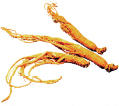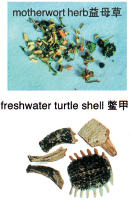There exist innumerable Chinese medicines, with many different names. These names are derived using the following criteria:

1.Naming based on the main effects of the medicinal materials.
E.g. motherwort herb is used to treat women’s menstrual disorders, thus it is named as “motherwort herb”; cassia seed is good for improving vision, thus named as “clear vision” (juemingzi ) in Chinese.
2.Naming based on the parts for making medicines.
E.g. the delicate twig of cinnamon twig  , tortoise carapace
, tortoise carapace  and freshwater turtle shell
and freshwater turtle shell  are all used to make medicines.
are all used to make medicines.
3.Naming based on the place of production.
E.g. as Yangchun  district of Guangdong province produces good quality amomum fruit (sharen
district of Guangdong province produces good quality amomum fruit (sharen  ), this medicine is also known asyangchun sha
), this medicine is also known asyangchun sha  in Chinese.
in Chinese.
4.Naming based on the form.
E.g. ginseng (renshen  ) is shaped like a human and is said to be potent enough to turn a situation around, thus its name is comprised of the Chinese characters for “man” (ren
) is shaped like a human and is said to be potent enough to turn a situation around, thus its name is comprised of the Chinese characters for “man” (ren  ) and “co-creating with the universe” (can orshen
) and “co-creating with the universe” (can orshen  ); Areca peel is named “big belly skin” (dafupi
); Areca peel is named “big belly skin” (dafupi  ) in Chinese as it is shaped like a big belly.
) in Chinese as it is shaped like a big belly.

5.Naming based on the smell and taste.
E.g. the fragrance (xiang  ) of cloves (dingxiang
) of cloves (dingxiang  ) andtanxiang
) andtanxiang  ; liquorice (gancao
; liquorice (gancao  ) and flavescent sophora root (kushen
) and flavescent sophora root (kushen  ) are named after their taste of sweetness (gan
) are named after their taste of sweetness (gan  ) and bitterness (ku
) and bitterness (ku  ) respectively.
) respectively.
6.Naming based on the colour.
E.g. safflower as “red flower” (honghua  ), gingko nut as “white fruit” (baiguo
), gingko nut as “white fruit” (baiguo  ), goldthread rhizome as “yellow stem” (huanglian
), goldthread rhizome as “yellow stem” (huanglian  ) in Chinese.
) in Chinese.
7.Naming based on the growing season.
E.g. the summer (xia  ) growing season of pinellia tuber (banxia
) growing season of pinellia tuber (banxia  ), prunella spike (xiakucao
), prunella spike (xiakucao  ), etc.
), etc.
8.Naming based on the imported herbs’ transliteration.
E.g. datura  .
.
9.Naming based on the natural disposition.
E.g. desert-living cistanche (roucongrong  ) is fleshy (rou
) is fleshy (rou  ).
).


Fast facts
Do you know where the nameduzhong (eucommia bark) came from?
Once, someone named Duzhong consumed this herb after falling ill, and was cured. The herb was therefore. named duzhong after him.


